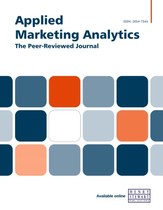A new model for optimal advertising impression allocation across consumer segments
Abstract
With conflicting recommendations and marketer practices about advertising impression allocation approaches (ie ‘the media strategy’), from approaches centred on reach (‘go broad’) versus targeting (‘get specific’), the debate rages on: ‘Are marketers targeting too much, not enough, or simply targeting the wrong consumers with their advertising?’ This paper interprets the issue of targeting as an advertising impression allocation question and instead of leading with case study evidence which by its nature is parochial, uses a novel mathematical approach to create an ad impression allocation model based on probability of choice. This contrasts with broad reach strategies and is different from other targeting schemes, eg key demographic, high lifetime value consumers, non-buyers for conquest, proprietary segments of interest. The findings suggest that targeting Movable Middles, ie those with a 20–80 per cent probability of choosing the brand of interest, can lead to 50 per cent improvement in return on ad spending (ROAS) versus broad reach media plans. The results are then supported with two in a large scale market case study. The Movable Middle, a segment of category buyers with a 20–80 per cent probability of choosing a brand, are shown to generate 2–23 times more ROAS than other category buyers who are mostly non-buyers of a brand. This pattern was uncovered mathematically but then subsequently verified empirically. By shifting about 10 per cent of ad impressions to audiences that have high concentrations of Movable Middles, a typical 10 per cent share brand can expect a 50 per cent improvement in campaign ROAS and a 13 per cent improvement in converting non-buyers. This leads to better serving brand needs for both quarterly sales and for long-term growth via customer acquisition. This new media strategy is not just limited to digital campaigns; it can be implemented across any media channel, including linear TV, radio and print.
The full article is available to subscribers to the journal.
Author's Biography
Joel Rubinson is President of Rubinson Partners, Inc., equipping media, research providers and AdTech companies with analytics, measurement and growth models for a digital age. Joel is the former Chief Research Officer at the Advertising Research Foundation. Joel functions as the lead expert on advanced analytics for the MMA Global and is also known for his expertise regarding multi-touch attribution, brand tracking, new product forecasting, brand loyalty, ad effectiveness and shopper marketing. Joel holds an MBA with concentrations in statistics and economics from the University of Chicago where he studied under three Nobel Prize winners. Joel has taught at NYU Stern School of Business. Joel's blogs are widely read, and he is a frequent speaker at conferences in the USA and abroad.
Neil B. Morley is Vice President of Marketing Solutions Product at TransUnion. He has worked for TransUnion (and previously Neustar/Marketshare) for 15 years developing measurement techniques to improve and unify MMM (marketing mix modelling), MTA (multi-touch attribution modelling) and experimentation insights in the marketing space. Dr Morley has an MS and PhD in nuclear engineering from UCLA where he was also an adjunct professor and his BS is in electrical engineering from the University of New Mexico.
Vassilis Bakapoulos is the Senior Vice President – Head of Industry Research for the MMA. In this role, he is responsible for defining the organisation's learning agenda and conducts research to tackle marketing's most important unanswered questions. He also sits on the Board of Trustees of the Advertising Research Foundation and the Content Board of I-com. Before joining the MMA, Vas held senior research and strategy roles at Digitas/Publicis and Kantar in New York and Europe.
Marc Vermut is a marketing strategy, data and analytics executive with more than 20 years of experience. Marc is responsible for driving thought leadership and innovation across TransUnion's Marketing Solutions TruAudience identity, segmentation, activation and measurement offerings, as well as delivering strategic insights that help brand leaders make better, more data-driven, marketing investment decisions. Marc received his BS in economics from the Wharton School and his MBA from UCLA Anderson.
Citation
Rubinson, Joel, Morley, Neil B., Bakapoulos, Vassilis and Vermut, Marc (2023, October 1). A new model for optimal advertising impression allocation across consumer segments. In the Applied Marketing Analytics: The Peer-Reviewed Journal, Volume 9, Issue 2. https://doi.org/10.69554/BZUK8615.Publications LLP
